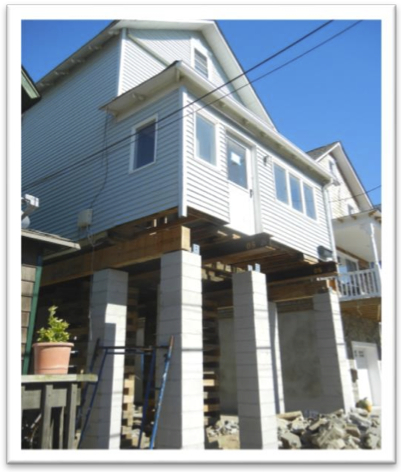October 5, 2016
Reading Time: 4 minutesTHIS ARCHITECT’S OPINION:
by Laurence E. Parisi, AIA
The residents of New Jersey are experienced with hard hitting storms which have caused death and destruction; however, Superstorm Sandy has topped them all as the most destructive hurricane ever recorded in the Garden State. Hurricanes are ranked by the number of deaths and the amount of destruction they cause. There is only one unnamed storm that landed on the Jersey Shore, in 1806, which stands second in line to Sandy. Hurricanes such as Irene, Floyd, Felix and Doria are all ranked as severe storms to have hit New Jersey. Homes were destroyed and some were swallowed by the sea; however, without hesitation the communities were rebuilt, renewed, and brought back to life and existed as the Jersey Shore we know and love without being raised fifteen feet above sea level.

My best buddy Mel and I enjoying the sand, surf & sun on the beach at Manasquan, NJ, summer 1962. This was 2 years after Category 2 Hurricane Donna with her 105 MPH wind gusts, heavy rain and a 6 ft. storm surge.
The flavor and essence of the Jersey Shore holds endearing memories for all of us who have grown up in this environment. From the Atlantic Highlands to Cape May, and the many shore communities in between, the shore has brought us joy and happiness. The sun, the surf, the warm summer breezes, and the sea swept salty air with the gentle aroma of tanning oils are fond memories. From the dunes of Love Ladies to the soft swell of Sea Girt with her gentle lighthouse. And what child hasn’t enjoyed the boardwalks of Asbury, Seaside Heights, Wildwood, and Point Pleasant; they all have a special place in our heart.
The question in my mind is: do we really need to raise the homes? The rush to elevate homes appears to be rash, abrupt, and is rapidly changing the complexion of the shore environment to an irreversible state that will leave some of the communities so bitterly unattractive that they will no longer be a pleasant, viable place to live or visit. One cannot take a home, raise it 12 to 15 feet above the grade and expect it maintain the quality of life that existed prior to the elevation. Notwithstanding, actual historic homes of such fine architectural quality of design will be aesthetically destroyed by such actions. The mandate for elevating shore homes within certain zones has not been fully rationalized and considered by governmental agencies to be the right thing to do. It is all being swayed by politicians who feel compelled to do something for their constituents but are not fully utilizing the professional design community. Raise homes but not the general stores, commercial buildings or post offices? What about the churches? What is that all about?
Homeowner’s insurance as well as flood insurance was meant to pay for losses; not to force homeowners to elevate their homes to avoid paying for future losses. These superstorm incidents happen maybe once in a lifetime. On some occasions, it may happen at shorter intervals but we shouldn’t have to pay double for damages done and future avoidance. A reasonable scenario on how this disaster recovery should play out is: we have a damaging storm, the insurance company pays for the damages, and the owner is able to rebuild and renew.

Photo illustrating the new look of the Jersey Shore taken by Michael Calafati, AIA.
In the wake of Sandy, the New Jersey Shore and other communities were left ravaged not only by storm but by the slow and aloof response from insurance companies, the State, and the Federal Government. This amount of destruction is beyond comprehension and several years later many families are still stranded. Individual homeowners who can afford to fix their homes at their own expense are complying with FEMA’s absurd directive that we must raise elevations in some areas to 15 feet above sea level. The State and Federal government are acting with a broad stroke approach to the relief efforts in that they have taken to the side of protecting the insurance industry, which has elected to avoid paying for the devastation caused by the storm and empowered FEMA to underwrite flood plain elevations that hypothesize and overemphasize elevation levels based on a pseudo- scientific premise. The burdens of the cost to repair homes and raise their elevation are cast onto the homeowner. Neither government, nor insurance companies, are willing to support the homeowners in relief that should be a given. Home owners have been paying policy premiums for generations, and when it comes time to receive their rightfully-deserved insurance benefits, they are put off, declined, and limited to the minimum. This is commonplace across the board for the private insurance industry or Federal support.
What is the purpose of requiring homes to be elevated above an assumed elevation? Is it the insurance industry’s quest to increase the odds that if the building stands they will not have to pay the owner? Are they self-insuring at the expense of the homeowner? The owner pays the premium no matter what, and when there is a claim the insurance companies seek every way possible not to pay. The question arises: How high is enough? As global warming continues will the elevation requirement rise in a few years? Will FEMA require homes to be raised again?
Something to think about, I welcome your thoughts and opinions.
By admin | Posted in AIA-NJ News, Editorial, NJ Architect Newsletter | Tagged: Disaster Response, Jersey Shore, Laurence Parisi, SUPERSTORM SANDY | Comments (1)
Architects are creative professionals, educated, trained, and experienced in the art and science of building design, and licensed to practice architecture. Their designs respond to client needs, wants and vision, protect public safety, provide economic value, are innovative, inspire and contribute positively to the community and the environment.

414 Riverview Plaza, Trenton, NJ 08611
(609) 393-5690
info@aia-nj.org
My, albeit limited, understanding is like this:
A house not raised above the flood plain = extremely high premiums
A house raised above flood plain = reasonable premiums
There comes a point however, that when a house is raised to a certain level (as determined by the insurance companies or FEMA or magical charts), to gain access to the ‘reasonable’ premiums, when the question, “Does it makes sense to have flood insurance?”, must be asked. Obviously, a bank providing financing is going to require it regardless, but if water level reaches any significant elevation above the determined first floor height, then there is going to be nothing left…anywhere. And the possibility of rebuilding on a barrier island that has received such an impact from the ocean is going to be highly unlikely for anyone.
Homeowners should be ready for the possibility that no one will be allowed to build or re-build in these sensitive locations, with or without insurance. Enjoy the areas while accepting the risk that is inherently a part of living by the ocean on glorified sand bars.
I question how much influence the insurance companies had in categorizing Sandy from a hurricane to a “super storm”, enabling them to deny claims from homeowners with specific hurricane insurance. These companies are never going to willingly do anything to help their customers, and unfortunately the raised houses will become a standard sight, regardless of their need or usefulness.
On LBI, I have seen the effect that a street full of raised houses has had on the tight neighborhoods. It is unfortunate that it becomes much more difficult to interact with neighbors on the street, parents have more difficulty keeping any eye on kids as they play, and lets not even get in to what happens to elderly residents who have even more trouble understanding the changes, are being taken advantage of by shady contractors, and now need an elevator to get into their home.
Yes, the landscape is changing, but in the end mother nature will take it back to they way she wants it. The only thing that will remain will be the pilings that once held houses full of families, memories, pictures, sand toys, surf boards, and fishing poles, sticking up through the chop of the Atlantic Ocean, visible at low tide from passing boats and the mainland.